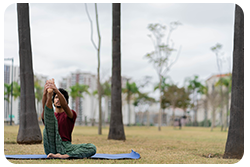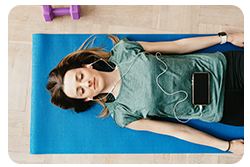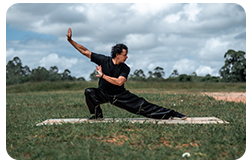Are you looking to crush your health goals and achieve a stronger, fitter, and happier version of yourself? If so, you may want to consider the power of mindfulness. This increasingly popular practice has been shown to have a profound impact on physical health, helping individuals build healthier habits, make sustainable lifestyle changes, and even reduce stress and anxiety.
But what exactly is mindfulness, and how can it be applied to health and fitness? In this blog, we'll explore the science of mindfulness and its connection to physical health, as well as provide practical exercises and suggestions for lasting change to inspire and guide your wellness journey. So, get ready to flex your mindfulness muscle and transform your health from the inside out!
The Science of Mindfulness
 Mindfulness is a term that is often associated with meditation or being in the present moment. It involves paying attention to your thoughts, feelings, and physical sensations without judgment. Recent research has shown that mindfulness can have a positive impact on physical health and wellness.
Mindfulness is a term that is often associated with meditation or being in the present moment. It involves paying attention to your thoughts, feelings, and physical sensations without judgment. Recent research has shown that mindfulness can have a positive impact on physical health and wellness.
One of the key benefits of mindfulness is stress reduction. When we experience stress, our bodies produce cortisol, which can have negative effects on our physical health over time. By practicing mindfulness, we can learn to manage our stress and reduce the production of cortisol in our bodies. In fact, a study conducted by the University of California, San Francisco found that mindfulness meditation reduced the expression of genes that are associated with inflammation and stress.
In addition to reducing stress, mindfulness can also help us build healthier habits and make sustainable lifestyle changes. This is because mindfulness helps us tune in to our bodies and recognize when we are hungry, full, or experiencing cravings. By being more mindful about our eating habits, we can make healthier food choices and develop a more positive relationship with food.
 Another benefit of mindfulness is injury prevention. When we are more aware of our bodies, we are less likely to overexert ourselves or push our limits in ways that could lead to injury. In fact, a study published in the Journal of Bodywork and Movement Therapies found that mindfulness-based exercises can help prevent common injuries in athletes.
Another benefit of mindfulness is injury prevention. When we are more aware of our bodies, we are less likely to overexert ourselves or push our limits in ways that could lead to injury. In fact, a study published in the Journal of Bodywork and Movement Therapies found that mindfulness-based exercises can help prevent common injuries in athletes.
Finally, mindfulness has also been shown to have a positive impact on sleep quality. When we practice mindfulness, we are more relaxed and less likely to experience racing thoughts or worries that can keep us up at night. By getting better quality sleep, we are more likely to have the energy and motivation to pursue our health and fitness goals.
Overall, the science of mindfulness is still being explored, but the evidence so far suggests that this practice can have a profound impact on physical health and wellness. By incorporating mindfulness exercises into your daily routine, you may be able to achieve your health goals in a more sustainable and enjoyable way.
Mindfulness Exercises for Health and Fitness
Now that we've explored the science of mindfulness, let's take a look at some practical exercises you can try to incorporate mindfulness into your health and fitness routine. These exercises are simple to do and can be adapted to fit your personal preferences and goals.
 Body Scan Meditation – The body scan meditation is a great way to connect with your body and identify areas of tension or discomfort. To do a body scan, find a quiet and comfortable place to sit or lie down. Close your eyes and focus on your breath. Then, start to scan your body from your toes to the top of your head, paying attention to any areas of tension or discomfort. As you scan each area, take a few deep breaths and visualize the tension or discomfort melting away.
Body Scan Meditation – The body scan meditation is a great way to connect with your body and identify areas of tension or discomfort. To do a body scan, find a quiet and comfortable place to sit or lie down. Close your eyes and focus on your breath. Then, start to scan your body from your toes to the top of your head, paying attention to any areas of tension or discomfort. As you scan each area, take a few deep breaths and visualize the tension or discomfort melting away.
 Mindful Eating – Mindful eating involves paying attention to your food and how it makes you feel. To practice mindful eating, start by choosing a small snack or meal. Before you eat, take a moment to look at your food and appreciate its colors, textures, and smells. Then, take a small bite and chew slowly, focusing on the taste and texture of the food. Pay attention to how you feel as you eat, and stop when you feel comfortably full.
Mindful Eating – Mindful eating involves paying attention to your food and how it makes you feel. To practice mindful eating, start by choosing a small snack or meal. Before you eat, take a moment to look at your food and appreciate its colors, textures, and smells. Then, take a small bite and chew slowly, focusing on the taste and texture of the food. Pay attention to how you feel as you eat, and stop when you feel comfortably full.
 Gratitude Practice – Gratitude is a powerful emotion that can help boost your mood and reduce stress. To practice gratitude, take a few minutes each day to reflect on the things in your life that you are thankful for. You can write them down in a journal or simply think about them in your mind. By focusing on the positive aspects of your life, you can cultivate a sense of happiness and contentment that can spill over into other areas of your life, including your health and fitness goals.
Gratitude Practice – Gratitude is a powerful emotion that can help boost your mood and reduce stress. To practice gratitude, take a few minutes each day to reflect on the things in your life that you are thankful for. You can write them down in a journal or simply think about them in your mind. By focusing on the positive aspects of your life, you can cultivate a sense of happiness and contentment that can spill over into other areas of your life, including your health and fitness goals.
 Mindful Movement – Mindful movement involves paying attention to your body as you move, whether it's through yoga, tai chi, or another form of exercise. To practice mindful movement, focus on your breath and how your body feels as you move. Pay attention to the sensations in your muscles, joints, and bones, and make adjustments to your movements as needed to avoid strain or injury. By being more mindful about how you move your body, you can develop a deeper connection with your physical self and improve your overall health and fitness.
Mindful Movement – Mindful movement involves paying attention to your body as you move, whether it's through yoga, tai chi, or another form of exercise. To practice mindful movement, focus on your breath and how your body feels as you move. Pay attention to the sensations in your muscles, joints, and bones, and make adjustments to your movements as needed to avoid strain or injury. By being more mindful about how you move your body, you can develop a deeper connection with your physical self and improve your overall health and fitness.
Incorporating these mindfulness exercises into your health and fitness routine can help you achieve your goals in a more sustainable and enjoyable way. By practicing mindfulness, you can reduce stress, build healthier habits, and cultivate a more positive relationship with your body and mind. So, give these exercises a try and see how mindfulness can transform your health and fitness journey.
Mindfulness for Lasting Change
 One of the best ways to understand the power of mindfulness in health and fitness is by looking at the lessons learned by others in their mindfulness journeys and examining the power of self-compassion.
One of the best ways to understand the power of mindfulness in health and fitness is by looking at the lessons learned by others in their mindfulness journeys and examining the power of self-compassion.
Lessons Learned – Over the past several years, practitioners of mindfulness have learned many valuable things that can provide inspiration and guidance for others looking to incorporate mindfulness into their health and fitness routines. Some key takeaways include:
1. Start Small – Mindfulness starts with small, manageable changes and gradually builds up to larger ones.
2. Stay Consistent – Mindfulness is a practice that requires consistent effort, but the results are worth it.
3. Be Patient – Change doesn't happen overnight, and it's important to be patient and compassionate with yourself along the way.
The Power of Self-Compassion – Finally, it's worth emphasizing the importance of self-compassion in creating lasting behavior change. Mindfulness teaches us to be kind and non-judgmental towards ourselves and to approach challenges with curiosity and openness rather than criticism and self-blame. By cultivating a mindset of self-compassion, we are better able to stay motivated and resilient in the face of setbacks and challenges and to make lasting changes that support our health and well-being.
Conclusion
Mindfulness is a powerful tool for improving health and fitness. By training the mind to be more present and aware, we can better manage our thoughts, emotions, and behaviors in ways that support our goals. Whether you're looking to lose weight, reduce stress, prevent injury, or simply feel better in your body, mindfulness can help.
Through the practical exercises and examples shared in this blog, you can begin to incorporate mindfulness into your own health and fitness routine. By doing so, you can tap into the many benefits of mindfulness, including increased focus, reduced stress, and greater self-awareness.
And while mindfulness may not be a magic bullet for achieving all of your health goals, it can provide an essential foundation for lasting behavior change. By cultivating self-compassion and a non-judgmental attitude, you can create a more supportive and sustainable relationship with your body and mind.
So, take a deep breath, and remember that each moment is an opportunity to practice mindfulness and to move towards greater health and well-being.







